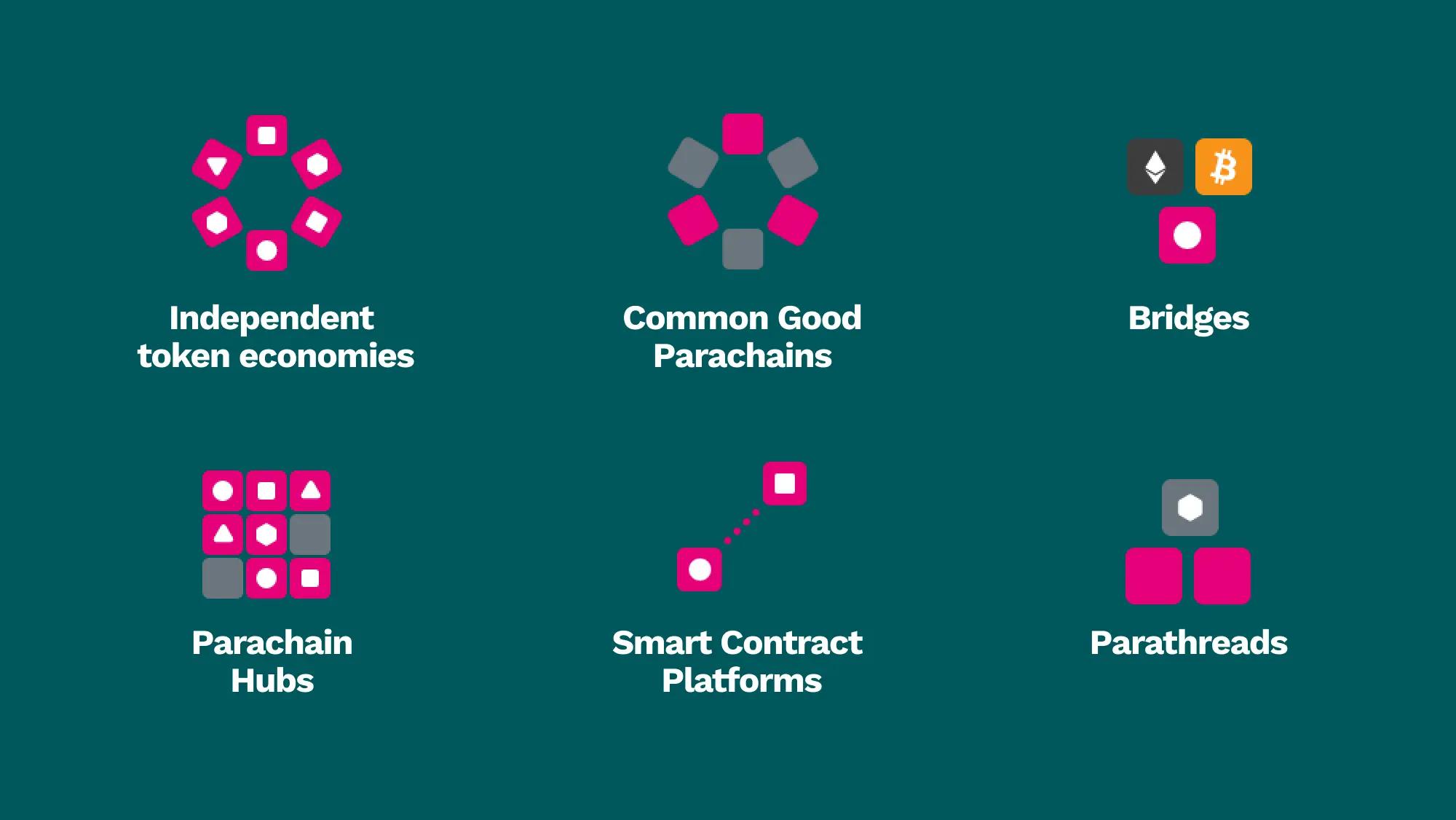The Parachain Advantage: Exploring Polkadot's Next-Generation Model
With the recent launch of Polkadot's first five auction-winning parachains, we take a closer look at the parachain model and the value this game-changing multichain technology brings to Web3.
 By Polkadot•December 16, 2021
By Polkadot•December 16, 2021
With the recent launch of Polkadot's first five auction-winning parachains, we take a closer look at the parachain model and the value this game-changing multichain technology brings to Web3.
Parachains explained
First conceived of in 2016, Polkadot's heterogeneous multichain model allows diverse, independent blockchains specialized for various purposes to work together under a unified security umbrella.
Parachains are next-generation layer-1 blockchains that put the 'multi' in multichain, forming the backbone of the Polkadot network and creating a free alliance of sovereign chains. Polkadot is the layer-0 protocol that underlies and supports this network of layer-1 parachains. Polkadot’s cross-chain interoperability allows any type of data or asset to be sent between parachains, creating a new paradigm of interchain services, communities, and economies. This multichain architecture allows Polkadot to form the basis of a new, decentralized internet, coined ‘Web3’ by Polkadot founder Dr. Gavin Wood.
The parachain model brings scalability to blockchain technology in a more decentralized and trustless way than relying purely on layer-2 scaling solutions. Transactions are spread across the network, taking place 'in-parallel' or simultaneously on several blockchains secured by a single set of decentralized validators.
Over 130 blockchain development teams around the world are currently building and launching their own parachains in Polkadot's growing ecosystem, due in large part to the distinct advantages the parachain model gives them over alternative technologies. In the case of Kusama, Polkadot's 'canary network,' several parachains are already live and running, and have processed several million transactions since summer 2021.
The main benefits of parachains
Polkadot's parachain model unlocks whole new realms of possibility for blockchain technology and the future of Web3. It can be difficult to sum up the true value of the parachain model, in part because it brings so many benefits. The following are just a few of them:
Specialization
The parachain model was created with the belief that the future of Web3 will involve many different types of blockchains working together. This is because no single blockchain design works optimally for every use case. Each chain comes with trade-offs making it well suited for some applications and less for others.
Just as the current version of the internet caters to different needs, blockchains need to be able to provide a variety of services: one chain might be designed for gaming, another for identity management, another for finance, etc. In connecting these diverse chains together, Polkadot lays the foundation for an internet of blockchains.
Parachains can be specialized for virtually every blockchain use case, and also represent a tool for experimenting with completely new use cases, especially on Kusama. Thanks to this specialization, parachains can do more working together than any single chain can do alone, creating a rich ecosystem where new decentralized economies can flourish.
Flexibility
Polkadot gives parachain developers the maximum possible flexibility when building their chain. The only technical requirement for being a parachain is that it must be able to prove to Polkadot validators that every block of the parachain follows the agreed-upon protocol. Beyond that, the sky's the limit for designing the perfect chain for any particular use case or set of use cases.
Building a parachain also gives blockchain developers much more flexibility than if they were building on top of a smart contract platform. When building at the smart contract layer, developers are locked into the design decisions of the underlying blockchain, which may not be optimal for their use case. Polkadot allows developers to drill down into the logic of the layer-1 parachain itself, unlocking far more possibilities for optimization.
The flexibility of the parachain model enables the broadest possible permutations of blockchain technology, fueling innovation in Web3 and overcoming the limitations and pitfalls of previous blockchain networks.
Interoperability
A key aspect of the parachain model is the ability for blockchains of differing design to communicate with each other. Polkadot's interoperability, also known as cross-chain composability, means blockchains are no longer isolated islands closed off from each other. Parachains end the era of siloed blockchains, creating a decentralized, connected internet of blockchains where before there existed only isolated networks with their own tribalistic communities.
Crucially, Polkadot allows parachains to send not only tokens but any type of data between each other, opening up a host of new blockchain use cases. Polkadot developers can build services that take advantage of the features of multiple blockchains, rather than being limited to the features of any one chain.
The true impact of interoperability can be felt when you consider the effect that free trade has on economies vs isolationism. Each individual blockchain is akin to its own independent nation, with its own internal community and economy. In this light, the parachain model represents a robust system for global free trade, ending the Balkanization and isolationism that holds back economic development and limits the influence of each individual chain.
Scalability
With the parachain model, Polkadot achieves scalability at layer-1, which is more decentralized and efficient than relying purely on layer 2. However, parachains can also incorporate layer-2 solutions, further increasing scalability. Polkadot allows transactions to be spread out and processed in parallel over an ecosystem of specialized layer-1 blockchains, significantly improving throughput and scalability over non-sharded networks.
In addition, several optimizations have been proposed that will allow Polkadot to continue improving scalability and transaction throughput into the future, while maintaining decentralization, security, and data availability. The last point is important, as other networks may prioritize TPS (transactions per second) at the expense of these important factors, but sacrificing decentralization for throughput defeats the underlying purpose of Web3.
Freedom from platform fees
Parachains connected to Polkadot can access as much computing power as they need without additional fees or “gas” costs. Polkadot's flexibility frees parachain teams and dapp developers to implement whatever fee structure they want for their users.
Best of all, users of parachains are not required to hold DOT tokens to interact with apps and services, and indeed don't even need to know that they're interacting with a blockchain. In this sense, the parachain model allows blockchain technology to overcome a significant barrier to usability and adoption that exists with legacy networks. Imagine if you had to hold a special token to pay fees every time you wanted to interact with an app on your phone. Indeed, freeing users from platform fees will be a major driver for mass adoption of Web3.
Security
New blockchains typically need to bootstrap their own security by building a network of validators or miners. This is an incredibly difficult and time consuming process, and many blockchains are left with a level of security that leaves them vulnerable to attacks.
Parachains get robust security automatically when connecting to Polkadot. This built-in security feature, also called shared security, provides newer blockchain teams with bank-like security at minimal effort on their part. It also gives them fewer barriers to entry and significantly reduces the time necessary to launch a new network.
Upgradability
We live in a world of constant innovation, where technology is advanced one day and out of date the next. Like all software, blockchains need periodic updates to add new features, fix bugs, and incorporate more advanced technologies as they become available. But upgrading conventional blockchains is a laborious process often involving ‘forking’ or splitting the chain, which slows innovation and sometimes rips communities apart.
Polkadot and its parachains can take advantage of easier, 'forkless' upgrades. This means parachains can be upgraded easily based on the will of their communities — so they can be ready for whatever the future holds. With the parachain model, blockchains can better evolve and adapt to changing conditions, which means they can continue to be relevant into the future as new technologies become available.
Independent, customizable governance
Parachains on Polkadot are free to adopt whatever governance model they see fit, and can access a number of pre-built modules for implementing various on-chain governance systems. The ability to access sophisticated on-chain governance mechanisms allows teams to significantly reduce the likelihood of hard forks of their chain that could risk splitting their communities in two.
On-chain governance also provides a means of accountable transparency for parachain communities, a prerequisite for many institutions and fiduciaries that often need to see clear decision making processes before getting involved in blockchain technology. When coupled with Polkadot's forkless upgrades feature, a robust system of governance allows parachains to maintain their leading edge while also promoting cohesion in their communities and ensuring all stakeholders have a say in the future of the network.
Financial agency
Parachains can also leverage on-chain treasuries to gain financial agency, acting autonomously to fund activities based on the will of their communities. Coupled with on-chain governance, treasuries allow parachain communities to easily take on the form of a DAO (decentralized autonomous organisation).
This opens the door to new decentralized funding models, from funding projects that are beneficial to the network, to decentralized philanthropy, decentralized sovereign wealth funds, and even cross-chain mergers and acquisitions. The parachain model thus gives blockchains the ability to 'act in the world' on a financial basis, something once reserved for centralized institutions and corporations.
Ease of development
Ultimately, the benefits above would have limited impact if developing a parachain was a prohibitively difficult process. But parachain development teams benefit from a wide array of development tools that make building a blockchain easier than it has ever been.
Substrate, a blockchain development framework built by Parity Technologies, is the primary Polkadot parachain SDK, helping teams significantly reduce the time and complexity of building a parachain. With Substrate, developers can take advantage of pre-built modules for common blockchain components that can be mixed and matched like blockchain building blocks to create the custom parachain best suited for their use case.
With parachains, what used to take years of painstaking work with large teams of expert developers can now be done in a matter of months with the resources of an early-stage startup.
The many forms of parachains

Since Polkadot gives parachain teams maximum flexibility to design the network that best suits their vision, parachains can and do take on a multitude of different forms, including:
Independent token economies: Parachains with their own native tokens, fee structures, and economic ecosystems.
Parachain hubs: Parachains that provide a range of functionality to serve a broader community or use case, such as DeFi hubs and governance hubs.
Smart contract platforms: Platforms for building and hosting smart contract based dapps and services, with support for Wasm-VM, EVM, and other types of virtual machines.
System parachains: Designed for the benefit of the entire Polkadot ecosystem, system parachains are approved by governance and operate on a non-profit basis, typically using Polkadot’s native token, DOT.
Bridges: Bridges allow Polkadot parachains and dapps to connect to external networks like Kusama, Bitcoin, and Ethereum.
Parathreads: Pay-as-you-go parachains for early stage networks and those that don’t need continuous connectivity to Polkadot. Parathreads are a proposed feature that will need to be added by Polkadot governance once developed.
Parachain slot auctions and crowdloans
Parachains connect to Polkadot by leasing an open slot on the Relay Chain via auction, which involves locking up a bond of DOT for the duration of the lease. DOT holders can help their favorite parachains win an auction, potentially earning a reward in return, by contributing to a crowdloan and temporarily locking their own DOT for the parachain’s bond.
Auctions and crowdloans raise the bar for blockchain projects, incentivizing them to demonstrate their technology and gain community support prior to launch. This reduces the likelihood of so-called ‘vaporware’ projects that raise funds without the intention or technical ability to deliver on their promises. Crowdloans also represent a fairer, more community-driven way of bootstrapping a native token in a decentralized way.
The cost of running a parachain
Parachains connected to Polkadot by leasing a parachain slot can access as much computing power as they need without additional fees or “gas” costs. Since the full amount of DOT bonded by a team for a parachain slot is unlocked at the end of the lease period, the cost of running a parachain is best described as the opportunity cost from not having access to the locked DOT for the duration of the lease.
Teams that choose to fund their slot via crowdloan may choose to reward their contributors in any way they see fit, representing an additional cost. Other minor costs include the expense of running collator nodes on the individual parachain.
For applications with a lot of users and traffic, running on Polkadot as a parachain is expected to be more economical than running as a solo blockchain or building on an existing smart contract platform.
Blockchain’s next generation
The parachain model takes blockchain technology into the next generation of innovation and adoption, greatly expanding the capabilities and impact of the technology. Ultimately, for Web3 to be successful, we need thriving ecosystems, platforms, and applications that work on the basis of collaboration, free trade, and open exchange rather than isolation and zero-sum tribalism. By enabling a rich ecosystem of specialized blockchains to work together based on their individual strengths and domain expertise, the parachain model creates the perfect conditions for thriving new Web3 economies — decentralized and unstoppable.











